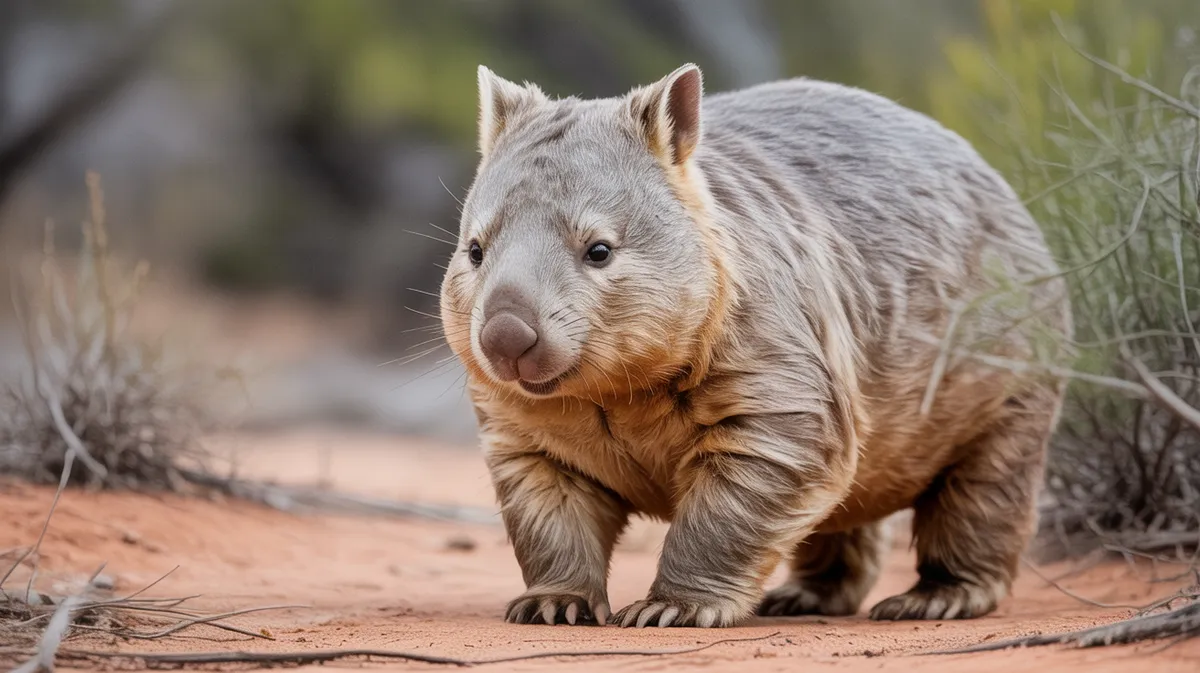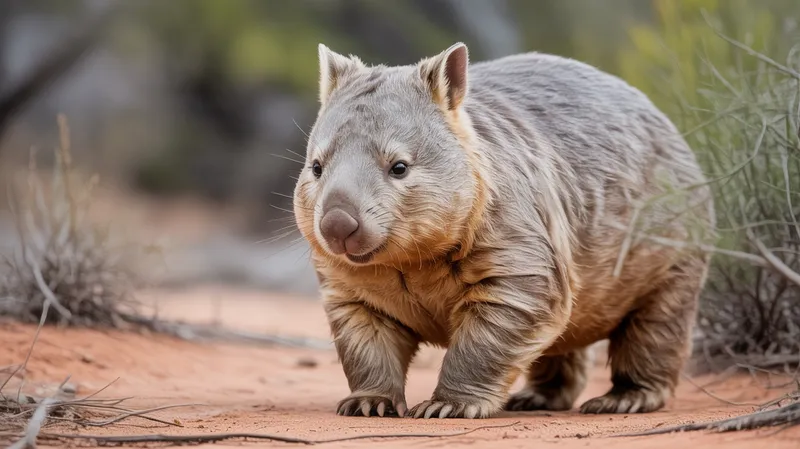
Hairy-nosed Wombat
Lasiorhinus

Meet the Hairy-nosed Wombat
The hairy-nosed wombat is a robust, burrowing marsupial native to Australia, recognized for its distinctive hairy snout and strong, stocky build. There are two species: the Southern Hairy-nosed Wombat (Lasiorhinus latifrons) and the critically endangered Northern Hairy-nosed Wombat (Lasiorhinus krefftii), both adapted to arid and semi-arid environments. These wombats are nocturnal, spending daylight hours in elaborate burrow systems to escape the harsh sun. Their powerful claws and muscular bodies allow them to dig extensive tunnels, which also provide protection from predators. Despite their tough appearance, hairy-nosed wombats are gentle herbivores with specialized teeth for grinding tough grasses.
Classification
Mammal
Habitat
Arid and semi-arid grasslands and woodlands
Diet
Herbivore
Lifespan
12-20 years
Conservation
Critically Endangered (Northern Hairy-nosed Wombat), Near Threatened (Southern Hairy-nosed Wombat)
Weight
19–40 kg
📖Fascinating Facts
Unique Nose
Hairy-nosed wombats have a leathery, hairy snout that helps filter dust while digging and foraging in dry environments.
Cube-shaped Droppings
Their unusual cube-shaped feces prevents droppings from rolling away, making scent-marking more effective in their territory.
Nocturnal Diggers
These wombats are mainly active at night, emerging from their burrows to feed when temperatures are cooler.
📋Detailed Description
Hairy-nosed wombats (genus Lasiorhinus) are medium-sized, robust marsupials characterized by their distinctive broad, flattened heads and densely furred, whiskered snouts, which differentiate them from the common wombat. Adults typically measure 77–100 cm in length and weigh between 19 and 40 kg, with males generally larger than females. Their pelage is soft, pale grey to brown, and their noses are covered in fine, sensitive hairs that aid in foraging. Both species possess powerful, stocky limbs and flattened claws, perfectly adapted for digging extensive burrow systems up to 30 meters long and 3.5 meters deep. These burrows provide stable microclimates, buffering the animals from extreme surface temperatures and aridity. Hairy-nosed wombats are primarily nocturnal, emerging at dusk to graze on tough native grasses and sedges, which they process with continuously growing, rodent-like incisors and specialized molars. Social structure varies: Southern Hairy-nosed Wombats (L. latifrons) may form loose colonies sharing interconnected burrow systems, while Northern Hairy-nosed Wombats (L. krefftii) are more solitary. Reproduction is slow, with females producing a single joey after a gestation of about 21–30 days; the young remain in the pouch for 6–9 months and are weaned by 12–15 months. Both species have low reproductive rates and long lifespans, sometimes exceeding 20 years in the wild. Their physiological and behavioral adaptations allow them to survive in some of the harshest environments of inland Australia.
💡 Did you know?
There are fewer than 300 Northern Hairy-nosed Wombats left in the wild, making it one of the rarest large mammals on Earth.
🔬Research & Sources
🎭Behavior & Social Structure
Hairy-nosed wombats are primarily nocturnal, spending daylight hours underground to avoid heat and dehydration. They emerge at dusk to feed, often traveling several kilometers in search of food. Their feeding behavior is highly selective, focusing on native perennial grasses such as Austrostipa and Aristida, which they crop close to the ground with their incisors. Southern Hairy-nosed Wombats may share burrow systems with up to 10 individuals, though direct social interaction is limited, and they are generally solitary foragers. Scent marking and dung piles are used for communication and territory delineation. Wombats are known for their methodical, slow movements above ground but can run at speeds up to 40 km/h for short bursts when threatened. They are highly territorial and may defend burrow entrances aggressively, using their toughened rumps as shields against predators or intruders.
👶Reproduction & Life Cycle
Breeding in hairy-nosed wombats is seasonal, typically occurring in late winter to early spring (August–October) when food availability is highest. Courtship involves scent marking and following, with males sometimes competing for access to females. After a short gestation of 21–30 days, the female gives birth to a single, underdeveloped joey, which crawls into the backward-opening pouch. The pouch phase lasts 6–9 months, after which the joey gradually emerges and begins grazing while still suckling. Weaning occurs around 12–15 months. Females may breed every 2–3 years, reflecting the species’ slow reproductive rate. Parental care is solely provided by the mother, and juvenile survival is closely tied to environmental conditions and food availability.
🛡️Adaptations & Survival
Hairy-nosed wombats exhibit a suite of adaptations for arid environments. Their burrowing lifestyle provides thermal refuge, maintaining burrow temperatures 10–15°C cooler than the surface and conserving humidity. Their kidneys are highly efficient, producing concentrated urine and dry feces to minimize water loss. The backward-facing pouch prevents soil from entering while digging. Their dentition is uniquely adapted: both incisors and molars grow continuously, compensating for wear from abrasive grasses. Behavioral adaptations include nocturnality and reduced activity during droughts. Social tolerance in Southern Hairy-nosed Wombats allows sharing of burrows, maximizing use of limited shelter. Their thick skin and cartilaginous rump plate protect them from predators and burrow collapse.
📚Research Sources
🎨Cultural Significance
Wombats, including the hairy-nosed species, hold a place in Aboriginal Australian mythology and oral tradition, often symbolizing tenacity and adaptation. Their burrows are sometimes referenced in Dreamtime stories. Historically, wombats were occasionally hunted for food by Indigenous Australians, but there is little evidence of widespread traditional use. In contemporary culture, wombats are celebrated as unique Australian fauna, featured in literature, art, and as conservation mascots. Their burrowing habits have sometimes brought them into conflict with farmers, but they are increasingly recognized as important ecosystem engineers.
🔬Recent Research & Discoveries
Recent research has focused on the population genetics of the Northern Hairy-nosed Wombat, revealing extremely low genetic diversity and prompting translocation and genetic rescue efforts. Studies of burrow microclimates have highlighted the importance of burrow structure for thermoregulation and survival in arid zones. Advances in remote sensing and camera trapping have improved monitoring of elusive populations. Ongoing research is investigating the impact of sarcoptic mange, a debilitating skin disease, and developing management protocols. Dietary studies using stable isotope analysis have refined understanding of seasonal foraging ecology. Conservation programs are exploring habitat restoration and the feasibility of establishing new populations to reduce extinction risk.
🎥Wildlife Videos

Everything You Need To Know About Wombats | Secret Life of the Wombat 101+102
In this series we meet common or bare nosed wombats, living in the woods of South East Australia and Tasmania, and southern ...
Love Nature

From 35 to 400: The Miraculous Comeback of the Northern Hairy-Nosed Wombat 🦡💚
From 35 to 400: The Miraculous Comeback of the Northern Hairy-Nosed Wombat This is the unbelievable true story of the ...
Safety Horizon

Wonders from Down Under: Northern Hairy-Nosed Wombat #endangeredspecies #wombats
simonj3413 @quintinscreaturecorner899 @_ethanol_ @spencerstark6420 @disneyvillainrocket1.
Thomas Huffman (AlphalionSimba)

Saving the Northern Hairy Nosed Wombat - one of the world's most endangered species | ABC Australia
Conservationists in central Queensland are using radar technology to map the burrows of one of the world's most endangered ...
ABC Australia

Northern Hairy-nosed Wombat Joey
In order to establish a second population of the northern hairy-nosed wombat, a site for the reintroduction had to be found. Several ...
Queensland Environment

Wombats Look Like Real Life Ewoks
----------- This episode was shot earlier this year before the mandatory lock down. ----------- Support Animalogic on Patreon: ...
Animalogic
🌍Habitat Information
The Hairy-nosed Wombat typically inhabits Arid and semi-arid grasslands and woodlands environments. Hairy-nosed Wombats have adapted to their environments with specialized features and behaviors.
Primary Habitat:
Arid and semi-arid grasslands and woodlands
More detailed habitat information will be available soon.
🛡️Conservation Status
The Hairy-nosed Wombat is currently classified as Critically Endangered (Northern Hairy-nosed Wombat), Near Threatened (Southern Hairy-nosed Wombat). Conservation efforts are crucial for preserving this species for future generations.
Common Threats:
- 🏠Habitat loss and fragmentation
- 🌡️Climate change impacts
- 🎯Hunting and poaching
- 🏭Human-wildlife conflict
⚠️Threats & Conservation Challenges
The Northern Hairy-nosed Wombat is critically endangered, with fewer than 315 individuals surviving in a single protected population at Epping Forest National Park, Queensland. Major threats include habitat loss from agriculture, competition with livestock and invasive species (notably rabbits and cattle), disease, drought, and genetic bottlenecks. Southern Hairy-nosed Wombats, while more numerous, face ongoing habitat fragmentation, road mortality, sarcoptic mange outbreaks, and competition for food and burrow sites. Both species are vulnerable to climate change, which exacerbates droughts and reduces food availability. Conservation challenges include maintaining genetic diversity, controlling disease, and restoring suitable habitat.
🔬Scientific Classification
Scientific Name
Lasiorhinus latifrons / Lasiorhinus krefftii
Classification Hierarchy
🔍 About Taxonomic Classification
Taxonomic classification is a hierarchical system used by scientists to classify and organize living organisms based on shared characteristics and evolutionary relationships.
The system moves from broad categories (Kingdom) to increasingly specific ones, with each animal's scientific name typically consisting of its Genus and species.
📝Community Notes
Share your observations and insights about the Hairy-nosed Wombat with our community of wildlife enthusiasts.
Join Our Community
Sign in to share your observations and connect with fellow wildlife enthusiasts.
Sign In to ContributeNo community notes yet
Be the first to share your observations about the Hairy-nosed Wombat!
Explore Hairy-nosed Wombat
Select a tab above to learn more about this amazing animal.
📸Photo Gallery
No photos available for this animal yet.
🌟Discover More Wildlife
Continue your journey of discovery with more fascinating animals from our database
